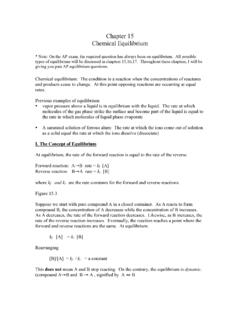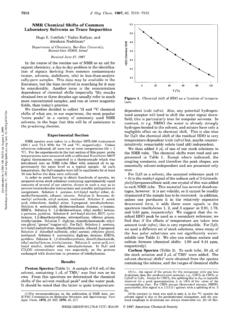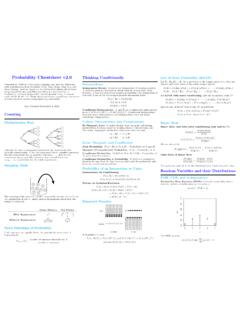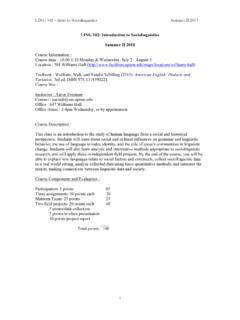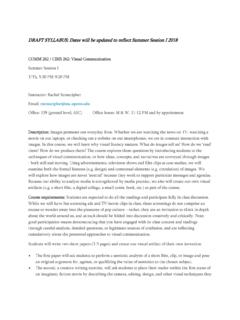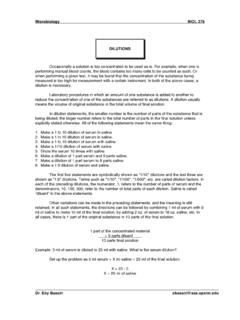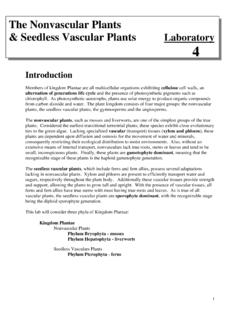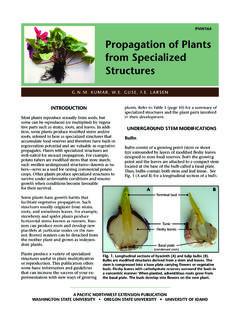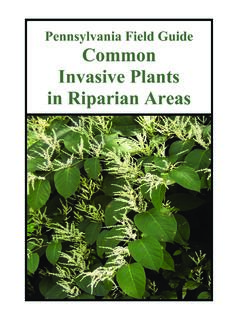Transcription of VEGETATIVE PROPAGATION TECHNIQUES Nov 18
1 VEGETATIVE PROPAGATION TECHNIQUES . PERRENIAL CROP SUPPORT SERIES. JALALABAD, AFGHANISTAN. Publication No. 2007-003-AFG. November 18, 2007. Roots of Peace VEGETATIVE PROPAGATION TECHNIQUES . This manual was produced by Roots of Peace under USAID subcontract No. GS-10F- 0359M, Task Order #306-M-00-05-00515-00, Afghanistan Alternative Livelihoods Program for the Eastern Region. It was written by Ferenc Sandor of Roots of Peace, with support from Juan Estrada of DAI for the use by Roots of Peace and Ministry of Agriculture, Irrigation and Livestock extension agents, farmers, agriculture input suppliers and other teachers. The work was funded by USAID under the Alternative Livelihoods Program, Eastern Region which is managed by Development Alternatives, Inc. (DAI). For more information, contact Roots of Peace at or +1 415 455 8008.
2 Roots of Peace is humanitarian, not-for-profit organization based in California, USA. Roots of Peace, established in 1997, focuses on post-conflict countries to eradicate remnants of war and to re-establish and promote economic livelihoods and social programs. Roots of Peace is funded by public and private sources. First published in Afghanistan in 2007 by Roots of Peace. All rights reserved. Page 2. Roots of Peace VEGETATIVE PROPAGATION TECHNIQUES . Table of Contents Introduction .. 4. Fruit Plant and Tree PROPAGATION Categories .. 6. VEGETATIVE PROPAGATION by Rooting .. 9. Stock Division .. 9. Runner Division .. 10. Layering .. 11. Banking 12. Simple Layering .. 12. Radial or Chinese Layering .. 12. Air Layering .. 12. Rooted Cuttings .. 13. Semi-Wooded Cuttings.
3 15. Truncheons .. 15. Root Cuttings .. 16. VEGETATIVE PROPAGATION by Graftage .. 17. VEGETATIVE PROPAGATION by Bud Grafting or Budding .. 17. T-budding .. 19. Inverted T-budding .. 19. Chip-budding .. 20. VEGETATIVE PROPAGATION by Grafting .. 20. Whip Grafting .. 22. Cleft Grafting .. 24. Bark Grafting .. 27. Green Grafting .. 33. Taking Care of Grafted and Budded Plants .. 34. Glossary of Terms .. 36. 38. Page 3. Roots of Peace VEGETATIVE PROPAGATION TECHNIQUES . Introduction This manual was produced to support perennial crop development in Eastern Afghanistan. It is the first of a series of manuals that will be produced. VEGETATIVE PROPAGATION TECHNIQUES Fruit Nursery Establishment Fruit Orchard Establishment Soil Testing Perennial plants can be propagated in VEGETATIVE or generative ways.
4 Fruit and nut trees are usually propagated by VEGETATIVE means using grafting methods. For this, there are two types of grafting methods: budding and grafting. Both of them are used for the same purpose - to create a new plant through the union of a suitable rootstock and an aerial part of another plant of the desired variety, called a scion. Other fruits are propagated by their own cuttings, such as stem, root and runner. This practice of VEGETATIVE PROPAGATION of fruit trees dates back to ancient times. China had been using grafting TECHNIQUES since pre-classical times. The Greeks and Romans adopted this strategy and spread these methods all over Europe. Sexual reproduction of fruit trees is a rarely used method in horticulture. Mainly applied in research stations to conserve the richness of the gene pool and develop new varieties.
5 On the production side, this method cannot satisfy the requirements for production quality and quantity. The new specimen, resulted from the sexual reproduction, carries unpredictable characteristics of its own, which includes the tendency to revert to a wild-like state of the specie. However, some of the known fruits keep intact their specific characteristics of the variety independently from the way, which was used for PROPAGATION . It can be sexual or asexual reproduction these fruits inherit the characteristics of the variety. The chestnut is a typical representative of this group. Plant can be asexually reproduced either by using part of two or more plants in a union or parts of the same plant. In the first case we call it graftage and in the second case we call it rooting.
6 All asexual PROPAGATION TECHNIQUES belong one of the two categories. Page 4. Roots of Peace VEGETATIVE PROPAGATION TECHNIQUES . Schematic 1: Fruit PROPAGATION Tools Source: Photograph by Ferenc Sandor Page 5. Roots of Peace VEGETATIVE PROPAGATION TECHNIQUES . Fruit Plant and Tree PROPAGATION Categories The methods to propagate asexually fruit plants are classified in two main and six sub categories: Rooting o Stock Division o PROPAGATION by Suckers o PROPAGATION by Runners o Layering o PROPAGATION by Cuttings Plant Union o PROPAGATION by Graftage Bud Grafting (Budding). Grafting Page 6. Roots of Peace VEGETATIVE PROPAGATION TECHNIQUES . The following list shows the most popular PROPAGATION TECHNIQUES by each category: Table 1: Rooting Options Division Stock Gooseberry, Currant, Strawberry, Hazel-nut Division Sucker Raspberry, Blackberry Division Runner Strawberry Bank up Gooseberry, Currant, layering Hazel-nut ROOTING.
7 Simple layering Hazel-nut Layering Gooseberry, Currant, Radial layering Hazel-nut Litchi, Guava, Macadamia, Air layering Mango, Avocado Hardwood Gooseberry, Currant, Simple cuttings cuttings Quince, Fig, Olive Torn cuttings Quince (dwarf). Rooting Cuttings Hammer cuttings Gooseberry Semi-wooded Gooseberry cuttings Truncheons Fig and others, which drip a white sap when cut Root cuttings Guava, Apple, Blackberry, Raspberry, Breadfruit Page 7. Roots of Peace VEGETATIVE PROPAGATION TECHNIQUES . Table 2: Graftage Options T-budding Pomegranate and Wooden fruit trees generally Budding Inverted T- Pomegranate and Wooden budding fruit trees generally Chip budding Pomegranate and Wooden fruit trees generally Whip grafting Simple whip Pomegranate and Wooden grafting fruit trees generally English (Tongue) Pomegranate and Wooden grafting fruit trees generally Cleft grafting Top cleft grafting Pomegranate and Wooden fruit trees generally Side cleft grafting Pomegranate and Wooden GRAFTAGE.
8 Fruit trees generally Bark grafting Top bark grafting Pomegranate and Wooden fruit trees generally Wedge grafting Pomegranate and Wooden Grafting fruit trees generally Slipping bark Pomegranate and Wooden grafting fruit trees generally Side bark grafting Pomegranate and Wooden fruit trees generally Bridge grafting Pomegranate and Wooden fruit trees generally Approach grafting Pomegranate and wooden fruit trees generally Green grafting Cleft type green Gooseberry grafting Whip type green Gooseberry grafting Page 8. Roots of Peace VEGETATIVE PROPAGATION TECHNIQUES . VEGETATIVE PROPAGATION by Rooting Stock Division This method is used when the plant produces custard of rooted stems. In the late growing season and at beginning of the dormant stage, we can divide the plant for several new specimens according to the number of rooted stems.
9 During this process, the old part of the plant should be removed. This technique basically rejuvenates the plant. Schematic 2: Stock Division Sucker Division There are two types of sucker division methods, both are based on the same principle. We use the growing suckers to reproduce the plant. In one case, the sucker grows from the bud, which is located around the root neck, or from roots, which are closed to the surface. Typical examples are the raspberry and the blackberry. In the other case, the sucker grows from the bud around the true stem, called rhizome, which is a horizontal underground stem. This technique is traditionally used for banana PROPAGATION . Page 9. Roots of Peace VEGETATIVE PROPAGATION TECHNIQUES . Schematic 3: Sucker Division Runner Division The most widely known example of propagating plants with runner division is the strawberry.
10 After fruiting, the strawberry begins to grow several runners. Wherever the runner has contact with the surface, it will root and form a new plant. After cutting off the new plant from the mother plant, we can transplant it before the cold season begins. The new plant will then produce fruit with its highest potential yield in the next year. Page 10. Roots of Peace VEGETATIVE PROPAGATION TECHNIQUES . Schematic 4: Runner Division Layering The main purpose of layering is to provide rooting for the stem of the mother plant. The new growing plant will keep the union with the mother plant until it is able to survive on its own. When this happens, the new plant will be cut off from the mother plant. Different TECHNIQUES (as shown) exist for layering. Page 11. Roots of Peace VEGETATIVE PROPAGATION TECHNIQUES .
